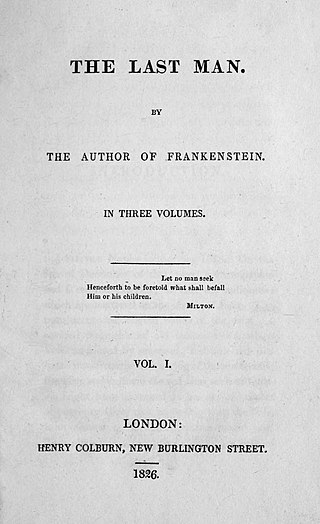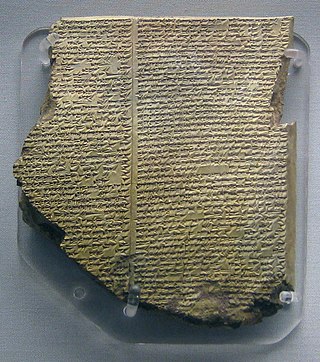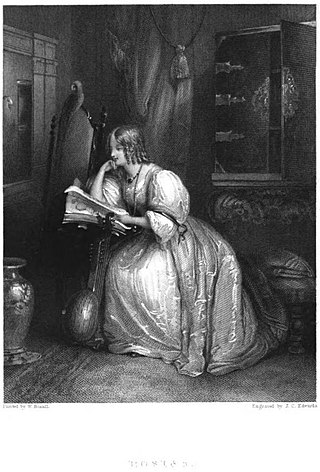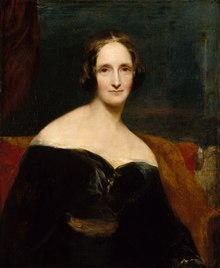
The Last Man is an apocalyptic, dystopian science fiction novel by Mary Shelley, first published in 1826. The narrative concerns Europe in the late 21st century, ravaged by the rise of a bubonic plague pandemic that rapidly sweeps across the entire globe, ultimately resulting in the near-extinction of humanity. It also includes discussion of the British state as a republic, for which Shelley sat in meetings of the House of Commons to gain insight to the governmental system of the Romantic era. The novel includes many fictive allusions to her husband Percy Bysshe Shelley, who drowned in a shipwreck four years before the book's publication, as well as their close friend Lord Byron, who had died two years previously.

Johann Konrad Dippel, also spelled Johann Conrad Dippel, was a German Pietist theologian, physician, alchemist and occultist.

Victor Frankenstein is a fictional character and the main protagonist and title character in Mary Shelley's 1818 novel, Frankenstein; or, The Modern Prometheus. He is a Swiss scientist who, after studying chemical processes and the decay of living things, gains an insight into the creation of life and gives life to his own creature. Victor later regrets meddling with nature through his creation, as he inadvertently endangers his own life and the lives of his family and friends when the creature seeks revenge against him. He is first introduced in the novel when he is seeking to catch the monster near the North Pole and is saved from near death by Robert Walton and his crew.
Mathilda, or Matilda, is the second long work of fiction of Mary Shelley, written between August 1819 and February 1820 and first published posthumously in 1959. It deals with common Romantic themes of incest and suicide. The narrative deals with a father's incestuous love for his daughter.

Valperga: or, the Life and Adventures of Castruccio, Prince of Lucca is an 1823 historical novel by the Romantic novelist Mary Shelley, set amongst the wars of the Guelphs and Ghibellines.

"Tithonus" is a poem by the Victorian poet Alfred, Lord Tennyson (1809–92), originally written in 1833 as "Tithon" and completed in 1859. It first appeared in the February edition of the Cornhill Magazine in 1860. Faced with old age, Tithonus, weary of his immortality, yearns for death. The poem is a dramatic monologue with Tithonus addressing his consort Eos, the goddess of the dawn.

Immortality is a common theme in fiction. The concept has been depicted since the Epic of Gilgamesh, the oldest known work of fiction. Originally appearing in the domain of mythology, it has later become a recurring element in the genres of horror, science fiction, and fantasy. For most of literary history, the dominant perspective has been that the desire for immortality is misguided, albeit strong; among the posited drawbacks are ennui, loneliness, and social stagnation. This view was challenged in the 20th century by writers such as George Bernard Shaw and Roger Zelazny. Immortality is commonly obtained either from supernatural entities or objects such as the Fountain of Youth or through biological or technological means such as brain transplants.

This is a bibliography of works by Mary Shelley, the British novelist, short story writer, dramatist, essayist, biographer, and travel writer, best known for her Gothic novel Frankenstein: or, The Modern Prometheus (1818). She also edited and promoted the works of her husband, the Romantic poet and philosopher Percy Bysshe Shelley. Until the 1970s, Mary Shelley was known mainly for her efforts to publish Percy Shelley's works and for Frankenstein. Recent scholarship has yielded a more comprehensive view of Mary Shelley’s achievements, however. Scholars have shown increasing interest in her literary output, particularly in her novels, which include the historical novels Valperga (1823) and Perkin Warbeck (1830), the apocalyptic novel The Last Man (1826), and her final two novels, Lodore (1835) and Falkner (1837). Studies of her lesser-known works such as the travel book Rambles in Germany and Italy (1844) and the biographical articles for Dionysius Lardner's Cabinet Cyclopaedia (1829–46) support the growing view that Mary Shelley remained a political radical throughout her life. Mary Shelley's works often argue that cooperation and sympathy, particularly as practised by women in the family, were the ways to reform civil society. This view was a direct challenge to the individualistic Romantic ethos promoted by Percy Shelley and Enlightenment political theories.
Falkner (1837) is the penultimate book published by the author Mary Shelley. Like Shelley's earlier novel Lodore (1835), it charts a young woman's education under a tyrannical father figure.

"Maurice, or the Fisher's Cot" is a children's story by the Romantic writer Mary Shelley. Written in 1820 for Laurette Tighe, a daughter of her friends Margaret King and George William Tighe, Mary Shelley tried to have it published by her father, William Godwin, but he refused. The text was lost until 1997, when a manuscript copy was discovered in Italy.

Frankenstein; or, The Modern Prometheus is an 1818 novel written by English author Mary Shelley. Frankenstein tells the story of Victor Frankenstein, a young scientist who creates a sapient creature in an unorthodox scientific experiment. Shelley started writing the story when she was 18, and the first edition was published anonymously in London on 1 January 1818, when she was 20. Her name first appeared in the second edition, which was published in Paris in 1821.

St. Irvyne; or, The Rosicrucian: A Romance is a Gothic horror novel written by Percy Bysshe Shelley in 1810 and published by John Joseph Stockdale in December of that year, dated 1811, in London anonymously as "by a Gentleman of the University of Oxford" while the author was an undergraduate. The main character is Wolfstein, a solitary wanderer, who encounters Ginotti, an alchemist of the Rosicrucian or Rose Cross Order who seeks to impart the secret of immortality. The book was reprinted in 1822 by Stockdale and in 1840 in The Romancist and the Novelist's Library: The Best Works of the Best Authors, Vol. III, edited by William Hazlitt. The novella was a follow-up to Shelley's first prose work, Zastrozzi, published earlier in 1810. St. Irvyne was republished in 1986 by Oxford University Press as part of the World's Classics series along with Zastrozzi and in 2002 by Broadview Press.

Iginio Ugo Tarchetti was an Italian author, poet, and journalist.

Mary Shelley's Frankenhole is an American adult stop motion-animated television series created by Dino Stamatopoulos for Cartoon Network's late night programming block Adult Swim. The series premiered on June 27, 2010 and ended on March 25, 2012, with a total of 20 episodes, over the course of 2 seasons.

Mary Wollstonecraft Shelley was an English novelist who wrote the Gothic novel Frankenstein; or, The Modern Prometheus (1818), which is considered an early example of science fiction. She also edited and promoted the works of her husband, the Romantic poet and philosopher Percy Bysshe Shelley. Her father was the political philosopher William Godwin and her mother was the philosopher and women's rights advocate Mary Wollstonecraft.

"The Evil Eye" is a piece of short fiction written by Mary Shelley and published in The Keepsake for 1830. The tale is set in Greece and is about a man known as Dmitri of the Evil Eye. Dmitri's wife was murdered and his daughter abducted many years before the story begins. Dmitri's friend Katusthius Ziani enlists him to help recover his rightful inheritance, and during their journey they abduct a boy whom Dmitri discovers to be his grandson.

Transformation is a short story written by Mary Shelley and first published in 1831 for The Keepsake. Guido, the narrator, tells the story of his encounter with a strange, misshapen creature when he was a young man living in Genoa, Italy, around the turn of the fifteenth century. He makes a deal with the creature to exchange bodies, but the creature does not reappear at the appointed time to take his own body back. Guido discovers that the creature is pretending to be him, kills it and therefore 'himself', and eventually awakens in his own body.

"The Dream" is a Gothic tale written by Mary Shelley and first published in The Keepsake for 1832. Set in France around the turn of the seventeenth century, it is the story of a young woman named Constance who is in love with Gaspar, the son of her father's enemy. Because their fathers killed each other in battle, Constance feels she cannot marry Gaspar, even though he loves her too. She spends a night on St. Catherine's Couch, a ledge of rock overlooking a river, in the hope that St. Catherine will offer her guidance in her dreams. She does, and Constance and Gaspar are married the next day.

The Invisible Girl is a Gothic tale written by Mary Shelley and first published in The Keepsake for 1833. The tale is set in Wales, and tells the story of a young woman named Rosina, who lives with her guardian, Sir Peter Vernon, and is secretly engaged to his son, Henry. Henry is away from home when their relationship is discovered, and Sir Peter casts Rosina out of the house. Sir Peter regrets his harshness and searches for her, but assumes she is dead when she cannot be found. Henry returns home to the news of Rosina's death and is heartbroken. He joins the search for her body, and the villagers tell him about the Invisible Girl, a ghostly figure who wanders the woods at night. Henry finds Rosina hiding in a remote ruin and discovers that she is really the Invisible Girl. Sir Peter forgives them for their secret engagement, and they are married.

Ferdinando Eboli is a Gothic tale written by Mary Shelley and published in The Keepsake for 1829. It is set in Italy during the Napoleonic Wars and tells the story of an Italian man named Count Ferdinando Eboli whose identity is stolen by his illegitimate older brother.


















